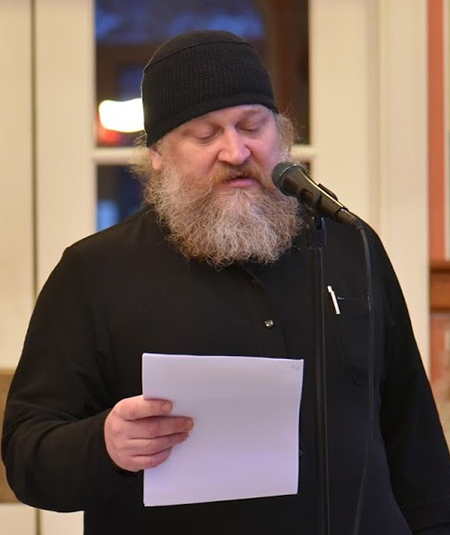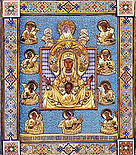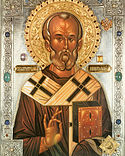6th Report of the VI All-Diaspora Council – by Deacon Victor (Zavodov) – on the “Sekach” Bishops

Report to the VI All-Diaspora Council on the “Sekach” Bishops
by Dcn. Viktor (Zavodov)
Beloved in the Lord Bishops, Fathers, Brothers and Sisters
I am compelled to devote my report to a complex issue. In 2008, two bishops from the so-called “Sekach” group were accepted into the ROCA. We must honestly say that this act of our hierarchs has seriously upset many of our priests and laity even causing some to completely leave our jurisdiction. It also frustrated people from other jurisdictions in the ROCA fragments, who up to that time were willing to reunite with ROCA. However, this put an abrupt stop to the very idea of such a reunification for many years to come. It is now essential for all of us to provide an accurate assessment of what occurred in 2008, and to try to find the correct way out of the situation.
The History
The “Sekach” hierarchy originates from the self-ordained “schema-metropolitan” Gennady Sekach, who “was ordained into bishophood” by the layman Michael Pozdeyev. Depending on circumstances, Michael Pozdeyev used to call himself either “Grand Duke Michael,” or “Archbishop Seraphim of Smolensk and Orel “. According to Michael Pozdeyev, he (Michael) was supposedly raised to the episcopal rank by his Holiness Patriarch Tikhon (Bellavin) two days prior to the Patriarch’s death in 1925. However, during his arrest and subsequent investigations, he readily admitted that through such deceptive acts he was attempting to find out whether the Imperial Family was still alive, in order to “report this to the appropriate authorities”. Michael also personally gave a signed written oath to the civil (bolshevik) authorities to report on any of the untrustworthy: “if I hear something from someone or if I see and recognize, who is against the authorities and is conspiring against the government, then that very hour I will be reporting this to the appropriate authorities, signed Michael Alekseievich Pozdeev”.
The True Orthodox Church (TOC) (the Russian Catacomb Church) only becomes aware of “Bishop” Seraphim Pozdeev from 1944. It appears that his activities as “bishop” commence from this year (rather than from 1925). Neither schema-bishop Peter (Ladygin), nor other old-Tikhonite-Josephite catacomb pastors recognized his “bishophood”.
Not only is the ordination of Seraphim (Michael) Pozdeev highly questionable, but so is the later “ordination” of hieromonk Gennady (Sekach) to “bishop” by “bishop” Seraphim Pozdeev acting on his own. According to witnesses, no such ordination ever took place. Furthermore, there was not even a Liturgy during which such an “ordination” could have taken place. The half-paralyzed and half-blind Seraphim Pozdeev, after dinner, only gave a blessing to Gennady to become a bishop, having laid his hands on him, and no more. Here is what Vera Kaliuzhnaia, a witness of that “ordination”, recalls: “Father Gennady was not ordained by Bishop Seraphim Pozdeyev of Smolensk, because the Bishop had already taken the grand schema as Anthony, and due to his old age and sickness could not serve a liturgy… The bishop was lying in bed seriously ill but wearing a diamond panagia. Seeing Father Gennady, he took off his panagia and put it on Father Gennady and said, “you will be a bishop”, then immediately removed the panagia and put it back on himself. Bishop Seraphim never ordained Father Gennady to the bishophood…”. This was also confirmed by Bishop Seraphim Pozdeyev’s novice, Ludmila Saadaeva. Furthermore, Gennady Sekach did not have any ordination documents from Pozdeyev, which also confirms him as an impostor.
So, it turns out that the founder of the “Sekach” group did not have any episcopal rank. He may have been ordained just a hieromonk by the Moscow Patriarchate, or may have simply been an impostor in a cassock. No documents confirming his own ordinations or the “ordinations” of those “ordained” by him to the rank of “bishop” and “priest” were ever able to be presented. In any case we are not aware of any of them!
Concelebrating with these sorts of people, especially at the level of liturgical communion, is unacceptable and spiritually harmful for correctly ordained clergymen if they sincerely desire their own salvation and that of their flock!
When Metropolitan Philaret was the First Hierarch of ROCOR, information seeped abroad through some unknown channels from the USSR, that the Catacomb Church was still functioning, having not succumbed to the communist regime. You can only imagine the joy that this news brought to the Russian hierarchs and ordinary people living in exile! The ROCOR Synod then began receiving letters from members of the Catacomb Church. But without the ability to check all the writers, and not knowing the actual situation of the Church in the homeland, they gave a blessing for the commemoration of the episcopate of Church Abroad to almost anyone who applied, almost without any discernment.
Of course there were correctly ordained priests among the clergy in Russia since some clergymen from tsarist times were still alive (we are aware of such examples). But there were also charlatans (self-proclaimed clergymen), as well as provocateurs specially assigned for interaction with those abroad (for example from the so-called “Rotovsky catacombs” – a Moscow Patriarchate deliberate substitute for the Catacomb Church, a creation of Metropolitan Nikodim Rotov).
When the Soviet system became somewhat weaker, the ROCOR ordained a bishop for the Russian Catacomb Church, Bishop Lazar (Zhurbenko) (this is exactly what his ordination documents stated). Bishop Lazar received a blessing from the Synod to establish contact with members of the Russian Catacomb Church. Bishop Lazar did this for several years in the early 1990’s. Most unfortunately, Bishop Lazar was confronted with a rather sad situation. The persons presenting themselves as “Catacomb Church bishops” were not able to prove the validity of their ordinations with any documents, and furthermore, did not show their best side from a purely moral perspective. The overwhelming majority of priests ordained during the tsarist period had passed away by this time. Those still alive, at best refused to accept Bishop Lazar (through their bitter experience of self-isolation and secrecy), and in the worst case –were false-elders, or those same provocateurs from within the false-catacombs or self-ordained “clergymen”, such as the Sekachevtsy, Lipkovtsy, Alfeevtsy and so on. In such circumstances, the flocks left without pastoral care after their priests passed away ran wild and spiritually fell almost to the levels of savage paganism and magism. Similarly, the flocks under the pastorship of self-proclaimed clergymen acting as false elders fell into primitive sectarianism disguised by an “Orthodox cloak.”
The ROCOR Synod of Bishops issued their famous resolution in 1990 in reliance upon Bishop Lazar’s findings: “The Synod of Bishops of the Russian Orthodox Church Outside of Russia has its own legal representative within the territory of Russia, in the person of His Eminence Lazar, Bishop of Tambov and Morshansk. The Synod, due to the absence of sufficient evidence, regretfully concludes that it cannot accept that the underground hierarchs have valid apostolic succession and have been canonically ordained.”
There were other examples. Hieromonk Alexander (Orlov) served the Omsk catacomb parish for some 30 years. Fifteen years after his death, his spiritual children joined priest Vasily Saveliev, who by then had left the MP, and went under the authority of the ROCOR Synod. To this day these catacomb parishioners, who unfortunately become fewer in number with each passing year, form the backbone of this Siberian parish.
Some may object by stating that the actions of Bishop Lazar are not a valid indicator, and that reasons existed as to why he was mistrusted by catacomb parishioners. To this I will reply: “Yes, Bishop Lazar is a controversial and ambiguous figure. But the ROCOR Synod, after the well-known events in Suzdal, made yet another attempt to gather the dispersed catacomb groups into one. This time the investigations were entrusted to His Grace Evtihy (Kurochkin) – and again they produced similar conclusions! I cannot forget how Bishop Evtihy, after his visit to another catacomb parish, with pain told us the horror stories about the “elders – miracleworkers”, the spiritually damaged parishioners, and the lack of proper church consciousness by both “pastors” and their flock…
I myself, being a deacon in the Omsk parish of the New Martyrs and Confessors of Russia, through my work have travelled to such secret parishes in Siberia, the Urals and Kazakhstan. I have personally met with catacomb church members, and I agree with the conclusions made by Bishops Lazar and Evtihy. To repeat again, I say with deep regret that only those who entered into prayerful communion with the Russian Church Abroad managed to spiritually survive. I am unaware of any other examples! I consider this as evidence of the workings of the Spirit of God, even if He had earlier shone His Grace onto the catacomb parishes in the USSR. However, by the beginning of 2000 those parishes had become lawless and lost their healthy church consciousness, degenerating into self-reliant anti-Moscow Patriarchate sects.
We don’t intend to offend the good Christians within the so-called “Sekach” group. Many of them have kept their faith in the Lord Jesus alive for decades. In whichever way they could, they carried the word of God to the surrounding aggressive godless world. Many suffered in communist torture chambers and camps. We admire their struggles and kiss their wounds. But we cannot accept their current self-reliance and false-eldership as a saving ideology! It is incorrect to think that the ROCOR Synod in 1990 rejected the catacomb groups in the former Soviet Union. On the contrary, we read the Guidelines from the Office of the Synod of Bishops of 2\15 August 1990 for №4 \ 77 \ 135:
“The Synod of Bishops of the Russian Orthodox Church Outside of Russia determines that the clergy (priests and deacons) of the above ordinations, who wish to enter into communion with the Russian Orthodox Church Outside of Russia, and the Free Russian Orthodox Church, should correct their canonical status through ordination (if they have no canonical obstacle to this) from the hands of bishops recognized by the Russian Orthodox Church Outside of Russia.
At the same time, the Synod of Bishops, seeking church unity amongst its flock, which is carrying its confessional cross in the Russian catacombs, calls on all catacomb bishops, for the good of the Holy Church, to document the authenticity of their apostolic succession, and to provide compelling evidence of their ordinations, or to take steps to correct their ordinations.”
This way the Synod showed maximum leniency to the catacomb bishops in their homeland. If the latter had displayed at least a little of a correct church-view and concern for their flocks (and were not just concerned about their own status), they could have accepted the fraternal assistance from their co-brothers outside Russia without too much trouble. Their episcopal ordinations would have become unblemished, and the work to guide Russia, our long-suffering country, out of its profound spiritual crisis would be glorious and priceless! Instead they preferred a secretive conspiratorial game not needed by anyone, which resulted in the vacuum of spiritual leadership of the people being logically taken over by the Moscow Patriarchate which they all so despised! So we recall the Savior’s parable of the talents:
“Take therefore the talent from him, and give it unto him which hath ten talents… but from him that hath not shall be taken away even that which he hath” (Matthew 25: 14-30).
As a result, we keep hearing of scandals amongst the catacomb groups in the Russian Federation. Representatives of the “Sekach” group do not allow us to get bored: they will anoint some man to the Russian throne, then they will fight against Individual Tax File Numbers (ИНН) and other electronic documents. Then declare Adolf Hitler a holy liberator of Russia, and glorify Rasputin, Ivan the Terrible and pop singer Igor Talkov as saints. Then they announce the end of the world and bury themselves in a cave in the forest! RTOC Bishop Hermogen (Dunikov), a former “Sekach” member, performed the “baptismal sacrament” on himself when he was already a bishop!!! Forgive me dear bishops and fathers, but this utter disgrace must be stopped!
In 2008, the ROCA Synod under Met Agafangel accepted into its jurisdiction two “Sekach” bishops – Bishop Ioann (Zaitsev) and Bishop Afanasy (Savitsky) and allowed both to retain their existing rank of “bishop”. This action contravened the “Statement of the Council of Bishops dated 2/15 May 1990 (Protocol № 6)” which stated that “the Council cannot recognize the ordinations within this catacomb group as being canonical”. On the basis of this decree of the Council, the ROCOR Synod indicates the possibility of the acceptance of the “clergy” from this non-canonical group through ordination (if they do not have any canonical obstacles to ordination). So all the clergymen “ordained” by “Sekach” bishops should only be accepted by ROCA after new canonical ordinations i.e. Heirotonia. Furthermore, if a “priest” requested re-ordination, he would initially be ordained a deacon and after that would be ordained to the rank of priest, as dictated by the canons.
Nothing of this was done by Metropolitan Agafangel. The bishops in the 2008 ROCA Temporary Supreme Church Authority (ВВЦУ) only undertook a supplementary laying on of hands (Cheirotesia) as a correction of the hierarchical ordinations of “bishops” John and Afanasy before both were accepted as bishops of the Temporary Supreme Church Authority. Their ordinations to diaconate and to priesthood, received from the non-canonical hierarchs, were not corrected. Thus, the Temporary Supreme Church Authority (ВВЦУ) violated the 1990 ROCOR resolution. Further, it accepted the “ordinations” to diaconate and to priesthood from the non-canonical Sekach “hierarchs”. And by accepting the bishops, it incorrectly assumed the existence of apostolic succession within the self-ordained “Sekach” group.
In this case, mere Cheirotesia is not appropriate from a canonical point of view. In accordance with the canons, Cheirotesia was used in the Church from ancient times but only for bishops and clergymen who had apostolic succession. It was used in instances where the ordinations were not completely canonical or performed during a division in the Church. But without apostolic succession, self-appointed “hierarchs” and “clergymen” can only be accepted into the Church through full ordinations (chierotonia). That is, through ordinations into the rank of deacon, then priest, and then bishop, which is confirmed by the ruling of the Council of the ROCOR in relation to the clergy within the “Sekach” group.
Internet-Sobor published an offensive article written by priest Alexander Lipin: “Brief comments on the statements of Archbishop Sophrony, former Bishop of St. Petersburg and Northern Russia, on the non-canonical so-called “Sekach” catacomb group “. Here Fr Alexander wrote that “the first official unification (ROCOR and the Catacomb Church – DV) occurred at the request of catacomb priests, who remained for various reasons without archpastoral care, by Holy Hierarch Philaret (Voznesensky) when he was the First Hierarch of ROCOR. Apart from existing documents, there is also evidence of a voice recording of St. Philaret made during his life.”
Indeed, Metropolitan Philaret spoke about dozens of requests from catacomb priests from Russia wanting to transfer to the jurisdiction of the ROCOR. However, Metropolitan Philaret is referring to canonical priests, and not to the self-appointed “Sekach” clergy! Why does Father Alexander equate the two groups? And why does he forcefully mislead his readers into believing in the existence of dozens of documents confirming the apostolic succession and canonicity of the “Sekach” group. To my question: “What are these documents?” Father Alexander simply replied: “There is a large pile of them!” I replied to him: “I do not need a large pile, just simply show me one(!) authentic document that confirms that the “Sekach” hierarchs have legitimate apostolic succession. That is enough for me”. In response, I received a large pile of personal insults and not a single document (which was to be expected)!
It is now possible to boldly and openly admit, that the decision to accept “Bishops” Afanasy and John “in their existing rank” was ill-advised and a hasty error, caused by an insufficient investigation. It is necessary to repent and to correct it. We cannot risk the eternal life of our congregations, who depend on their pastors, simply for the sake of people who are trying to impose onto our Church an alien ideology and a sectarian spirit.
I propose the creation of an authoritative commission to examine the “Sekach” clergy. I also recommend that ROCA faithful temporarily refrain from further liturgical conceleration with them. Lastly, I would like to stress that we should deal with them in a Christian manner with love and by avoiding all offensive behaviour. Through our good attitude towards them we should show the power of the compassionate love toward us all of our Lord Jesus Christ, Who was crucified for us, and for the “Sekachs”!

